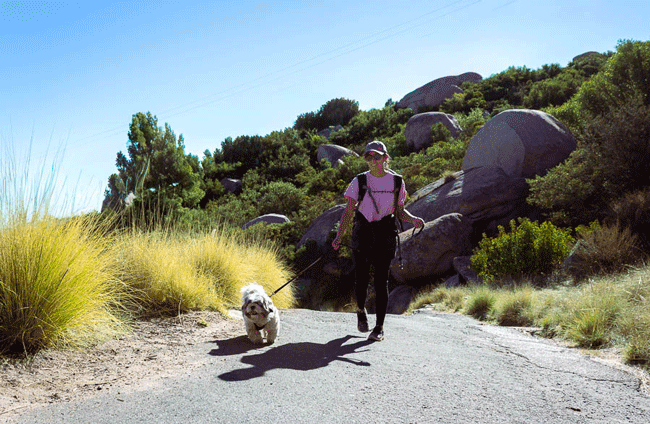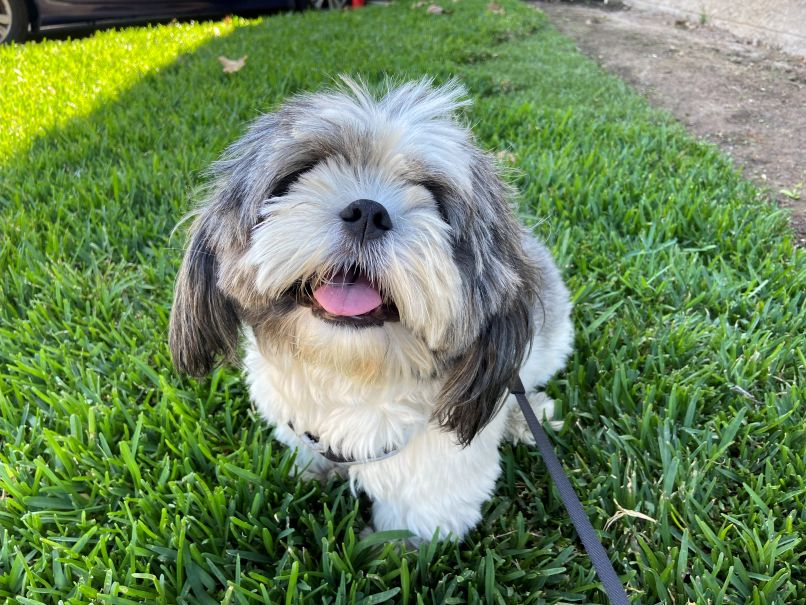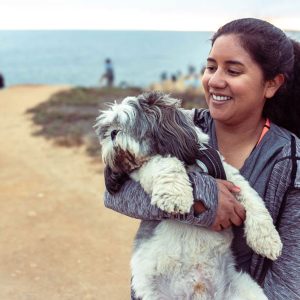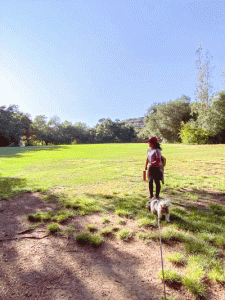Hi, this is Jess.
My sister and I have hiked all over San Diego—Lake Poway, Torrey Pines, Dos Picos. But when Tutú, our Shih Tzu, joined our family last year, we realized hiking with a dog here is completely different.
Our first real lesson came at Los Peñasquitos Canyon Preserve. Tutú stepped on something (we think an ant or bee), started yelping, and couldn’t put weight on his left paw. Watching him in pain while we were miles from the car was terrifying.
My sister Jeanette stayed calm, but our friend Jenny and I panicked. The three of us took turns carrying our 12-pound dog to the top of the mountain to catch that sunset.
It was a beautiful sunset but we all had sore arms that day.
That day taught me: never hike without a dog carrier backpack. I ordered the Kurgo G-Train Carrier the same night, plus a Dog First Aid Kit. Both have been lifesavers on every hike since.
After a year of trial and error (including some mistakes I’ll share), we’ve figured out what gear actually matters, when to hike, and how to keep your dog safe on San Diego trails. Here’s everything we’ve learned.
Hiking with Dogs in San Diego: What You Need to Know

Hiking with dogs in San Diego isn’t like hiking with dogs anywhere else. Our Mediterranean climate, diverse terrain, and unique wildlife create challenges that require specific preparation—especially if you’re hiking with a small dog.
Year-Round Heat Requires Strategic Timing
San Diego trails are accessible year-round, but the sun is relentless even in winter. Trail surfaces can reach 120°F+ in summer, burning your dog’s paws in seconds.
What we learned with Tutú: Always hike before 10am or after 4pm during warm months. Mid-day hikes are dangerous, even on short trails like Lake Miramar’s paved loop.
Terrain Varies Dramatically Across Trails
A flat, concrete trail at Lake Miramar requires completely different gear than the rocky, exposed paths at Los Peñasquitos Canyon or Potato Chip Rock.
What this means for your dog:
- Paved trails = minimal gear needed
- Rocky mountain trails = consider paw protection boots
- Sandy coastal trails = early morning timing to avoid hot sand
You can’t pack the same gear for every San Diego hike. Know your trail conditions before you go.
Wildlife Encounters Are Common
San Diego trails are home to rattlesnakes, coyotes, bees, and other wildlife that pose risks to curious dogs.
What we’ve encountered hiking with Tutú:
- Rattlesnakes on Los Peñasquitos trails (middle of the path, fully exposed)
- Bees at Elfin Forest (Tutú stepped on one – learned to carry dog backpack and first aid kit always)
- Coyote sightings at dawn/dusk on most trails
Your responsibility: Keep your dog on a short leash, scan the trail ahead constantly, and know what to do if you encounter wildlife. Small dogs like Tutú are especially vulnerable—he had no idea that rattlesnake was dangerous.
Foxtails and Native Plants Can Injure Dogs
San Diego’s chaparral landscape is filled with foxtails—barbed seeds that burrow into paws, ears, and noses. One foxtail can require emergency vet care.
Prevention: Stick to maintained trails, check your dog thoroughly after every hike, and avoid overgrown areas during foxtail season (spring/summer).
Bottom line: Hiking with dogs in San Diego requires more preparation than casual walks at home. The good news? Once you know what to expect and pack accordingly, these trails are some of the best dog-friendly adventures in California.
Best Times to Hike with Your Dog in San Diego

Timing your San Diego hike isn’t just about convenience—it’s about your dog’s safety and comfort. What feels like a pleasant 80-degree morning to us can quickly become dangerous for a Shih Tzu with thick fur.
Start Early or Wait for Evening We’ve learned the hard way to hike between 8-9am or wait until two hours before sunset. Usually during these times we don’t run risk of Tutú from overheating, and the ground temperature stays manageable for his paws. Evening hikes also reward us with breathtaking sunset colors—a bonus for our timing strategy.
Seasonal Adjustments During summer months, we skip morning hikes entirely and only go out in the evenings. If we do venture out during the day, we choose shaded parks or head to the beach instead of exposed trails. Winter gives us more flexibility, and we often hike in the evenings around December when temperatures are cooler throughout the day.
Our 80-Degree Rule
We don’t hike if the forecast shows 80°F or higher—period. Our sweet spot is 70°F or below, preferably early morning before the sun heats exposed trails.
Exception: Shaded trails like parts of Los Peñasquitos or beach walks (sand near water stays cooler) work in slightly warmer weather.
Seasonal Adjustments for San Diego
Summer (June-September):
- Evening hikes only
- Choose shaded trails or beaches
- Avoid exposed mountain trails entirely
Fall/Spring (October-May):
- More flexible timing
- Still aim for mornings when possible
- Watch for surprise heat spikes
Winter (December-February):
- Afternoon hikes are safe
- Cooler temps throughout the day
- Still bring water (San Diego rarely gets “cold”)
Bottom line: When hiking with dogs in San Diego, start early or wait for evening. Your dog’s comfort—and safety—depends on it.
Choosing Dog-Friendly Trails in San Diego

Not all “dog-friendly” trails work for every dog. Here’s how to pick trails that match your dog’s ability, breed, and experience level when hiking with dogs in San Diego.
Start with Your Dog’s Fitness Level
First-time hiking dogs: Stick to 1-2 miles on flat, paved trails (Lake Miramar, Fiesta Island)
Experienced hiking dogs: Gradually work up to 4-6 miles with elevation gain (Iron Mountain, Cowles Mountain)
Small breeds or short legs: Prioritize flat terrain under 3 miles (Lake Miramar, parts of Los Peñasquitos)
High-energy breeds: They can handle longer, more challenging trails—but still be aware of the heat
Trail Features That Matter for Dogs
When researching San Diego trails, look for:
✅ Shade coverage – Essential in San Diego heat (trees with shade)
✅ Water access – Some trails have bathrooms or dog water fountains
✅ Surface type – Paved/dirt (easier) vs. rocky/technical (harder on paws)
✅ Loop vs. out-and-back – Loops prevent “we’ve gone too far” situations
Red Flags to Avoid
Skip trails with:
❌Narrow exposed ridges (dogs can slip)
❌Steep drop-offs without barriers
❌Long isolated trails that have no present phone reception or out-and-back loops
❌ Overly crowded trails can overwhelm some dogs out -be aware of your dogs tolerance
How to Research Before You Go
- Check AllTrails reviews for dog-specific mentions
- Look for recent photos showing trail conditions
- Search “[trail name] + dogs” for San Diego hiking forums
- Call the park directly about current conditions (rattlesnake sightings, closures)
Pro tip: We always check the trail map before leaving now. If there’s no clear turnaround point, we set a distance limit (e.g., “2 miles out, 2 miles back”) so we don’t accidentally overcommit like we did that one time from Lake Poway to Potato Chip Rock – total 9 miles round trip.
Essential Gear for Dog Hiking?

The right gear makes the difference between a great hike and a disaster when hiking with dogs in San Diego. Here’s what we never leave home without—and why each item matters for your dog’s safety.
The Non-Negotiables
1. Dog Carrier Backpack
Why you need it: Even experienced hiking dogs get tired, injured, or overheated. When your dog can’t walk, you need a way to carry them off the trail safely.
We learned this the hard way when Tutú got stung and couldn’t put weight on his paw. Carrying a 12-pound dog for miles by hand is exhausting—and dangerous on uneven terrain.
What we use: Kurgo G-Train Dog Carrier Backpack → [Shop Kurgo Carrier]
Why it works: Padded straps, multiple compartments for gear, fits dogs up to 20 lbs comfortably
2. Dog Water Bottle
Why you need it: San Diego gets hot during summers, and hiking makes both you and your dog thirsty fast. Regular water bottles waste water and make it hard to hydrate your dog on the move.
What we use: Hemli 32 oz. Dog Water Bottle Dispenser → [Shop Water Bottle]
Why it works: Built-in bowl, leak-proof, comes with carrying strap, 32 oz capacity is enough for 2-3 hour hikes
Pro tip: Bring MORE water than you think you need. We ran out once and it was terrifying.
3. Dog First Aid Kit
Why you need it: Bee stings, cuts from rocks, foxtails in paws—trail injuries happen. You’re often 30+ minutes from your car on San Diego trails.
What we use: Arca Pet First Aid Kit → [Shop First Aid Kit]
What’s inside: Bandages, antiseptic wipes, tweezers for foxtails, tick removal tool, emergency info cards
Also pack: Benadryl (check dosage with your vet for bee stings/allergic reactions)
4. High-Value Treats
Why you need them: For recall training, rewarding good trail behavior, and redirecting attention from wildlife or other dogs.
What we use: Golden Rewards Duck Jerky Dog Treats → [Shop Dog Treats]
Why it works: Strong smell gets Tutú’s attention even when distracted, easy to break into small pieces
Note: Tutú is allergic to chicken and beef, so duck works for us. Most dogs respond best to real meat treats like chicken, beef, or duck—not peanut butter or banana. Test what YOUR dog finds irresistible before hitting the trails.
Nice-to-Haves (Depending on Trail)
- Paw protection boots (rocky trails like Iron Mountain)
- Cooling vest or bandana (summer hikes, even in morning)
- Long leash (10-15 ft) (for safe exploring on less crowded trails)
- Poop bags + carrier clip (always required on San Diego trails)
What We DON’T Recommend
❌ Button-operated water bottles – They break easily (learned this the hard way)
❌ Retractable leashes – Dangerous on narrow trails with bikes/other hikers
❌ Peanut butter or banana treats – Low-value for most dogs. Real meat treats (chicken, beef, duck) work better for recall training. Test what motivates YOUR dog before you need it on the trail.
Safety & Hydration Tips for Hiking with Dogs in San Diego

Preparation prevents emergencies when hiking with dogs in San Diego. Here’s what we’ve learned about keeping your dog safe and hydrated on the trail.
Hydration Guidelines
How much water does your dog need?
When Tutú first came into our lives, I had no idea how much water to bring on hikes. I started researching and found that according to PetMD, dogs need approximately 1 ounce of water per pound of body weight per hour of activity.
Tutú weighs 12 pounds, so that’s 12 ounces per hour on a moderate hike. For comparison, humans are supposed to drink about 8 ounces (1 cup) every 10-20 minutes during exercise, so dogs need proportionally similar amounts based on their size.
But here’s what I learned the hard way: San Diego heat changes everything.
On warm days (70°F+), double that estimate. A 12-pound dog like Tutú needs closer to 20-24 ounces for a 2-hour hike in San Diego summer heat. Larger dogs need even more—a 60-pound dog could need 120+ ounces (nearly a gallon) for a long summer hike.
Signs of Dehydration to Watch For
General warning signs:
- Excessive panting with thick, sticky saliva
- Sunken eyes
- Loss of skin elasticity (gently pull skin—it should snap back quickly)
- Lethargy or sitting down frequently
Tutú’s personal signal (and your dog might have one too):
I’ve learned to recognize when Tutú needs water. He’ll stop walking, look up at me, and just stare while panting—no barking, no pulling. That’s his way of saying, “I need a break and water.”
Your dog might have their own signal. Pay attention to behavior changes—some dogs will slow down dramatically, others might sit and refuse to move, and some look back at you repeatedly. Learn YOUR dog’s communication style.
Our Water Break Schedule with Tutú
I set a timer now to check in every 25 minutes, especially on sunny days. I pull out the water bottle and offer it—on hot days, he drinks immediately. On cooler days, sometimes he’ll sniff and walk away (meaning he’s good for now).
When I offer water MORE frequently:
- If he’s panting heavily even after we stop
- If he’s walking noticeably slower than his normal pace
- Any time the temperature is above 70°F
- On exposed trails with no shade
Why we avoid 80°F+ weather entirely:
Tutú has thick fur and overheats quickly. Even with frequent water breaks, hot weather is just too risky for him. We stick to early mornings or skip hiking altogether when it’s that warm. (See our timing section above for why the 80-degree rule matters.)
Pre-Hike Safety Checklist
Before leaving home:
I keep a hiking checklist on my phone now after forgetting essentials one too many times:
✅ Check weather forecast (temperature, UV index, wind)
✅ Tell someone your trail plan and when you’ll be back
✅ Verify the trail allows dogs (some San Diego preserves have restrictions)
✅ Make sure Tutú’s ID tag has the current phone number
At the trailhead:
✅ Let your dog relieve themselves before starting
✅ Do the “5-second hand test” on pavement (press your hand down—if it’s too hot for you, it’s too hot for paws)
✅ Offer water before you even start hiking
✅ Double-check you have poop bags (we’ve forgotten before—not fun)
On-Trail Safety Protocols
Keep your dog on a 6-foot leash (it’s required on most San Diego trails, plus it’s safer for wildlife encounters we’ve had)
Watch for warning signs your dog is struggling:
With Tutú, I’ve learned to watch his behavior closely:
- Excessive panting or drooling
- Slowing down significantly or lagging behind
- Limping or favoring a paw
- Sitting or lying down when he normally wouldn’t
- Looking back at me with “tired” eyes (you’ll recognize it)
If you see any of these: stop immediately, find shade, give water, and head back. Don’t push it.
Post-Hike Check

This is something I wish I’d known from day one—always check your dog before leaving the trailhead:
Before getting in the car:
✅ Check paws for cuts, thorns, or foxtails stuck between pads and ears for foxtails – Tutú gets a lot due to his thick fur
✅ Check body for ticks (run your hands over their fur)
✅ Offer water one more time
✅ Wipe muddy or sandy paws (saves your car interior)
Within 24 hours after the hike, watch for:
- Limping that wasn’t there immediately after
- Excessive licking of paws (sign of irritation or injury)
- Loss of appetite
- Continued lethargy beyond normal post-hike tiredness
If anything seems off, call your vet. I’ve learned it’s better to ask than wait.
Emergency Preparedness
Save these in your phone before you hike:
- Your regular vet’s number
- Nearest 24-hour emergency vet to your hiking area
I also looked up basic dog first aid after Tutú’s bee sting incident—things like how to remove foxtails from paws, what to do for insect stings (ask your vet about Benadryl dosage for your dog’s weight), and how to recognize heat stroke vs. just being hot and tired.
Trail Etiquette for Dog Owners

Following trail etiquette when hiking with dogs in San Diego keeps trails accessible for everyone and prevents dogs from being banned (it’s happened on some trails).
The Non-Negotiables
Always pick up after your dog – Pack out what you pack in. Yes, even on remote trails. Bag it, carry it to the trailhead trash.
Keep your dog on leash – Most San Diego trails require 6-foot leashes. Even if your dog has perfect recall, leash laws protect wildlife, other hikers, and your dog from unexpected encounters.
Yield to other trail users – Step aside for:
- Hikers going uphill (they have the right of way)
- Horses (move off the trail, let them pass calmly)
- Bikes (pull your dog close so the leash doesn’t trip riders)
Control your dog around other dogs – Not every dog is friendly. Ask before allowing dogs to greet, and keep Tutú close when passing other dogs on narrow trails.
Stay on designated trails – Don’t let your dog trample vegetation or chase wildlife. Stick to the path.
Be mindful of noise – If your dog barks excessively, work on training before hitting busy trails.
Our Favorite Dog-Friendly Trails in San Diego

After hiking with Tutú for over a year, these are the trails we return to again and again. Whether you have a small dog like Tutú or a high-energy trail dog, San Diego has options.
1. Lake Miramar Reservoir
Perfect for first-time dog hikers or small breeds. This paved, flat loop offers partial shade and beautiful lake views with plenty of wildlife watching. It’s a safe, family-friendly trail with other dogs and hikers—great for socializing your pup.
Best for: Small dogs, easy walks, hot days (some shade available)
2. Dos Picos Regional Park
Our favorite getaway when we want to escape the city for a day trip. Dos Picos offers a laid-back atmosphere with hiking trails under 3 miles—perfect if you’re looking for less crowded, shorter hikes with your dog. The park also has camping if you want to extend your adventure.
Best for: Peaceful hikes, beginner dogs, families, day trips from San Diego
Want more details? Read our post on Dos Picos dog-friendly day trip guide with what to pack, what we brought, and everything you need to know.
3. Mount Woodson Trail to Potato Chip Rock (CA-67 Entrance)
There are two ways to reach Potato Chip Rock—and trust me, the route matters.
The CA-67 paved route (RECOMMENDED): Park off Highway 67, walk through about 500 feet of dirt road, then you’re on a paved trail. It’s just over 2 miles to the famous Potato Chip Rock where everyone takes Instagram photos. This is the route we take with Tutú—manageable and safe for small dogs.
The Lake Poway route (NOT recommended for small dogs): This is 9 miles round trip (5 miles to Potato Chip, 4 miles back to Lake Poway). It’s dirt, rocky, and exposed. We attempted this once with Tutú and it was a disaster—I slipped and fell on loose rocks, we ran out of water, finished in the dark, and Tutú was covered head-to-toe in brown dirt. He was exhausted for two days. Never again.
Best for: The CA-67 paved route works for most dogs. Skip the Lake Poway route unless you have an experienced trail dog and are prepared for a challenging full-day hike.
What Dog Owners Ask Us About Hiking in San Diego
Can I hike with my puppy in San Diego?
I’m not a vet, so I’d recommend consulting with yours first—there are different opinions online about when it’s safe to start hiking with puppies. Generally, most vets suggest waiting until your puppy is fully vaccinated (around 16 weeks) and starting with short, flat trails. Your vet knows your puppy’s development best and can give you personalized guidance on distance and terrain.
Do I need dog boots for San Diego hiking?
Depends on the trail. Paved trails like Lake Miramar don’t need boots, but rocky trails like Iron Mountain can be tough on paws. We use boots for Tutú on rocky terrain or when temperatures are above 75°F and pavement gets hot. Do the 5-second hand test—if the ground is too hot for your hand, it’s too hot for paws.
Are there off-leash dog trails in San Diego?
Very few. Most San Diego trails require 6-foot leashes for safety and wildlife protection. Fiesta Island and some designated dog parks allow off-leash, but hiking trails generally don’t. Even if your dog has perfect recall, leash laws are enforced and protect your dog from rattlesnakes and other hazards.
What’s the best time of year to hike with dogs in San Diego?
Fall, winter, and spring (October through May) are ideal. Summer heat is dangerous for most dogs, especially those with thick coats like Tutú. If you hike in summer, go before 10am only and stick to shaded trails. We avoid hiking entirely when temperatures reach 80°F or higher.
How do I know if a trail is too hard for my dog?
Start with easy, flat trails (1-2 miles) and watch your dog’s behavior closely. Signs a trail is too hard: excessive panting, slowing down significantly, sitting down frequently, or staring at you without moving (that’s Tutú’s signal he needs water and a break). Build up distance and difficulty gradually over several weeks.
Can small dogs hike in San Diego?
Absolutely! Our 12-pound Shih Tzu Tutú hikes regularly. Stick to flat, paved trails (Lake Miramar, Mount Woodson paved route) and keep distances under 3-4 miles. Always bring a dog carrier backpack like our Kurgo G-Train for when small legs get tired. We learned this the hard way after carrying Tutú by hand for miles.
What should I do if my dog gets stung or bitten on the trail?
This happened to Tutú at Los Peñasquitos, and I wasn’t prepared. I didn’t have tweezers or a first aid kit to remove the stinger on the trail, so I watched him closely for allergic reactions (excessive swelling, difficulty breathing, lethargy). Thankfully, he didn’t show any signs of allergies.
Once we got home, I was able to remove the stinger. That day taught me to always carry a pet first aid kit with tweezers, Benadryl (ask your vet for the proper dosage for your dog’s weight), and antiseptic wipes. Now we never hike without it.
Ready to Explore San Diego with Your Dog?
Hiking with dogs in San Diego is one of the best ways to bond with your pup while discovering this beautiful city. Yes, it takes preparation—but seeing Tutú’s excitement on every trail makes it all worth it.
Want more San Diego dog adventure ideas? We’re constantly exploring new trails, beaches, and dog-friendly spots around the city.
Follow along:
- 📍 Pinterest – Save our guides for your next adventure
- 🎥 YouTube – Watch our hiking adventures with Tutú
-Jess